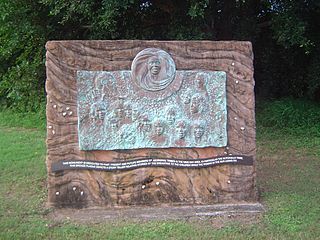
The Gulf of Carpentaria is a large, shallow sea enclosed on three sides by northern Australia and bounded on the north by the eastern Arafura Sea. The northern boundary is generally defined as a line from Slade Point, Queensland in the northeast, to Cape Arnhem on the Gove Peninsula, Northern Territory in the west.

Mornington Island, also known as Kunhanhaa, is an island in the Gulf of Carpentaria in the Shire of Mornington, Queensland, Australia. It is the northernmost and largest of 22 islands that form the Wellesley Islands group. The largest town, Gununa, is in the south-western part of the island.

The Wellesley Islands, also known as the North Wellesley Islands, is a group of islands off the coast of Far North Queensland, Australia, in the Gulf of Carpentaria. It is a locality within the Shire of Mornington local government area. The traditional owners of the islands are the Lardil people. In the 2016 census, the Wellesley Islands had a population of 1,136 people, all living on the largest island, Mornington Island.
Nicholas "Nick" Evans is an Australian linguist and a leading expert on endangered languages. He was born in Los Angeles, USA.

The Shire of Mornington is a local government area in northwestern Queensland, Australia. The shire covers the Wellesley Islands, which includes Mornington Island; the South Wellesley Islands; Bountiful Islands; and West Wellesley / Forsyth Islands groups in the Gulf of Carpentaria.

Lardil, also spelled Leerdil or Leertil, is a moribund language spoken by the Lardil people on Mornington Island (Kunhanha), in the Wellesley Islands of Queensland in northern Australia. Lardil is unusual among Aboriginal Australian languages in that it features a ceremonial register, called Damin. Damin is regarded by Lardil-speakers as a separate language and has the only phonological system outside Africa to use click consonants.

Kayardild is a moribund Tangkic language spoken by the Kaiadilt on the South Wellesley Islands, north west Queensland, Australia, with fewer than ten fluent speakers remaining. Other members of the family include Yangkaal, Lardil, and Yukulta (Ganggalidda). It is famous for its many unusual case phenomena, including case stacking of up to four levels, the use of clause-level case to signal interclausal relations and pragmatic factors, and another set of 'verbal case' endings which convert their hosts from nouns into verbs morphologically.

The Gulf Country is the region of woodland and savanna grassland surrounding the Gulf of Carpentaria in north western Queensland and eastern Northern Territory on the north coast of Australia. The region is also called the Gulf Savannah. It contains large reserves of zinc, lead and silver. The Gulf Country is crossed by the Savannah Way highway.

The South Wellesley Islands is an island group and locality in the Gulf of Carpentaria within the Shire of Mornington, Queensland, Australia. The group is separate from the Wellesley Islands.
Dick Roughsey was an Australian Aboriginal artist from the Lardil language group on Mornington Island in the south-eastern Gulf of Carpentaria, Queensland. His tribal name was Goobalathaldin, meaning “the ocean, dancing”, describing a “rough sea”. He was an active and prominent figure involved in reviving and preserving the cultural life of the Lardil people. His best known works are a series of children's picture books that retell traditional Aboriginal stories including “The Rainbow Serpent”.
Salomon Sweers was a bookkeeper and a counsel for the Dutch East India Company. His younger brother was Admiral Isaac Sweers employed by the Admiralty of Amsterdam.

The Quandamooka people are Aboriginal Australians who live around Moreton Bay in Southeastern Queensland. They are composed of three distinct tribes, the Nunukul, the Goenpul and the Ngugi, and they live primarily on Moreton and North Stradbroke Islands, that form the eastern side of the bay. Many of them were pushed out of their lands when the English colonial government established a penal colony near there in 1824. Each group has its own language. A number of local food sources are utilised by the tribes.

Sweers Island is an island in the South Wellesley Islands in the Gulf of Carpentaria, Queensland, Australia. Privately owned via a perpetual lease and with the only residents being the owners and workers at the resort, the island is within the Shire of Mornington.
The Lardil people, who prefer to be known as Kunhanaamendaa, are an Aboriginal Australian people and the traditional custodians of Mornington Island in the Wellesley Islands chain in the Gulf of Carpentaria, Queensland.
The Kaiadilt are an Aboriginal Australian people of the South Wellesley group in the Gulf of Carpentaria, Queensland, Australia. They are native to Bentinck Island, but also made nomadic fishing and hunting forays to both Sweers and Allen Islands. Most Kaiadilt people now live on Mornington Island, although one group has returned to Bentinck Island.
David McKnight was a Canadian-British anthropologist and ethnographer who specialized in the anthropology of Australian Aboriginal people, with particular regard to the tribes of the Cape York Peninsula. He conducted over 20 field trips among Aboriginal people in Australia from 1965 to 1999.

The Butchulla, also written Butchella, Badjala, Badjula, Badjela, Bajellah, Badtjala and Budjilla are an Aboriginal Australian people of K'gari, Queensland, and a small area of the nearby mainland of southern Queensland.
Mirdidingkingathi Juwarnda Sally Gabori was an Aboriginal Australian artist who at age 81 began painting in an abstract-like style she developed to represent her Country, on the south side of Bentinck Island in Queensland, Australia.











